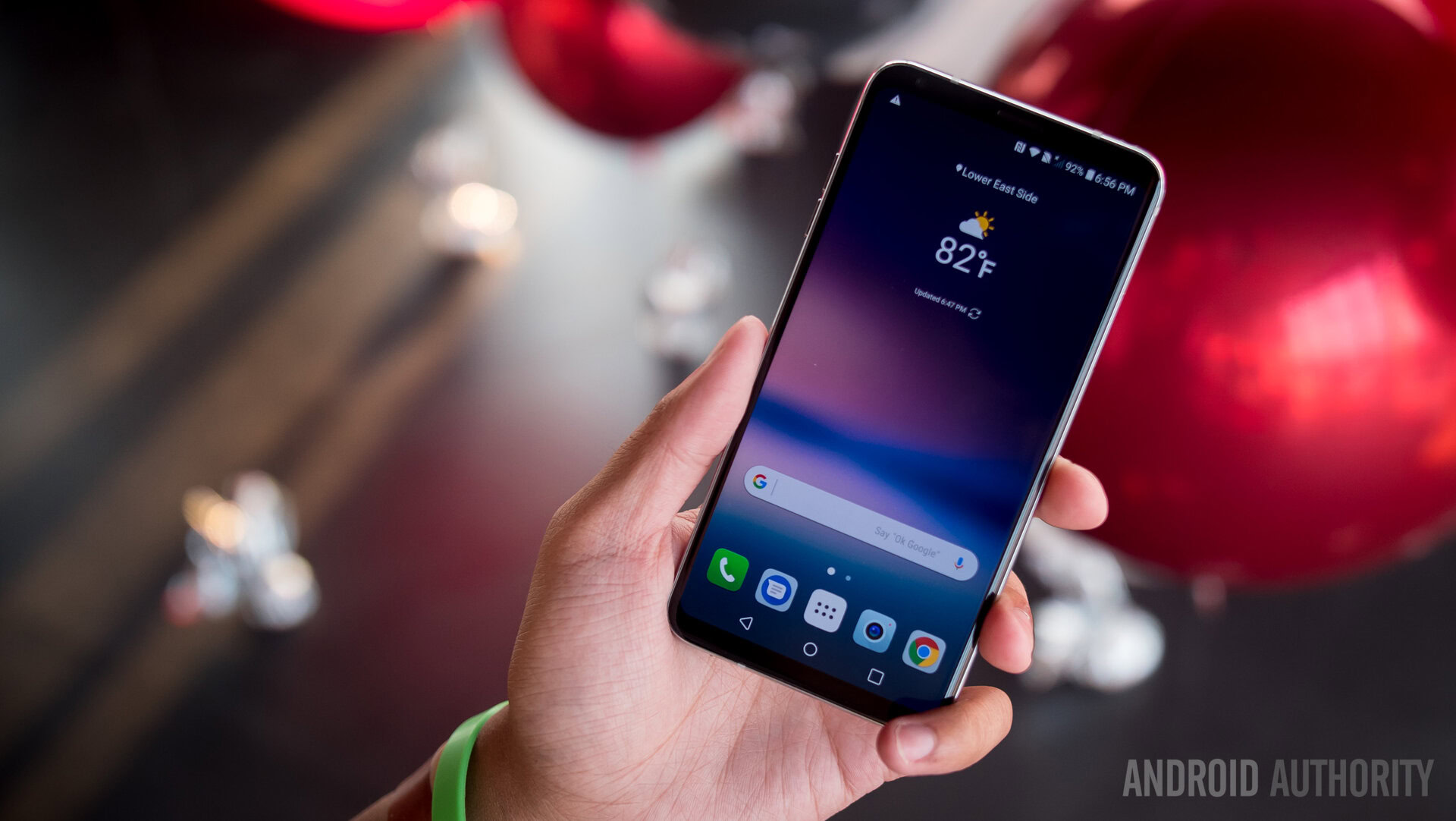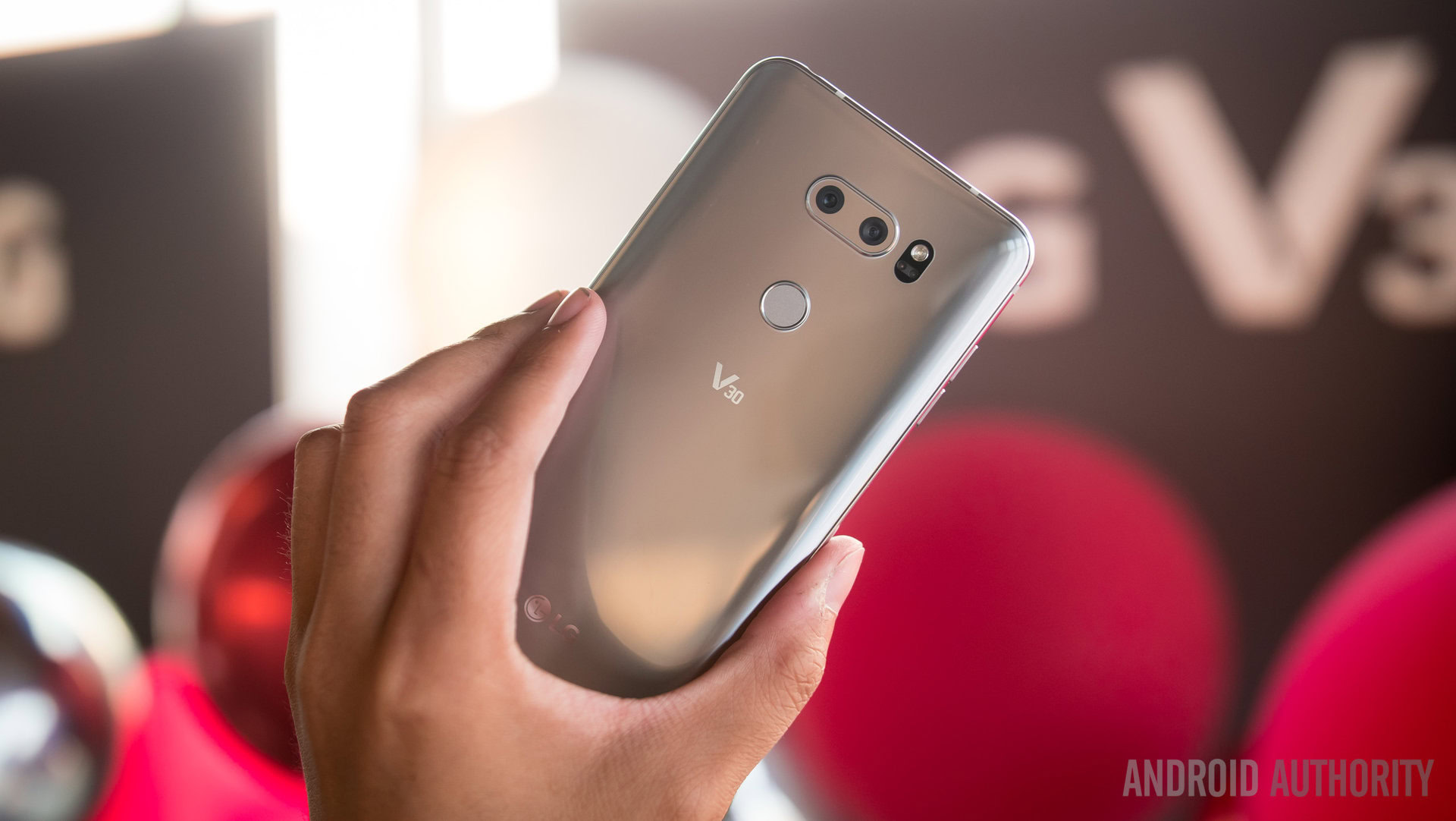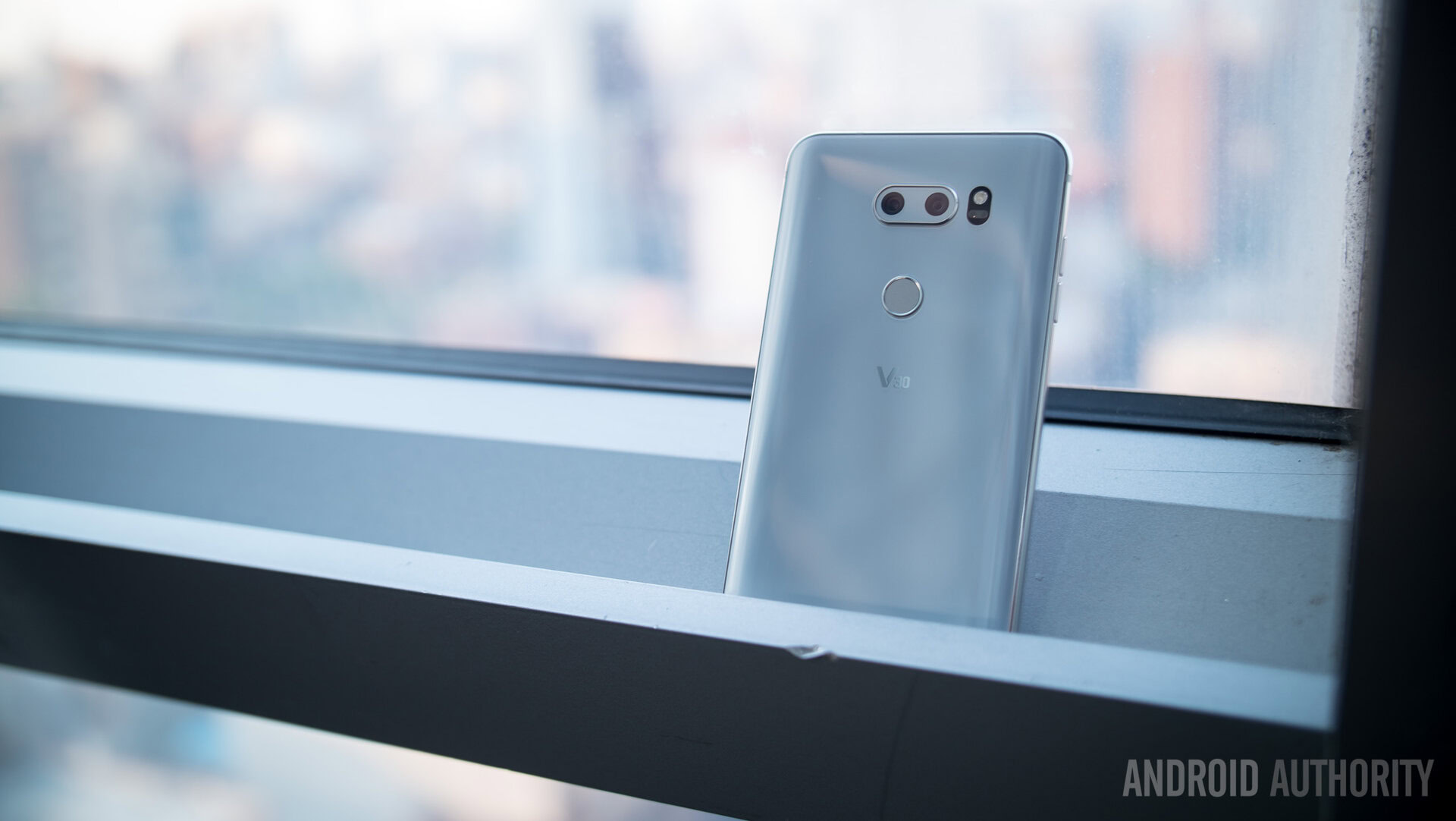Affiliate links on Android Authority may earn us a commission. Learn more.
LG V30 versus the competition
Published onAugust 31, 2017

After helping kick off a new smartphone display trend that sees manufacturers shrink bezel sizes to levels we have never seen before, LG looks to take all that it has learned with the G6 and improve on it with the V30. From the looks of it, the V30 is poised to make a strong case as an alternative to the Galaxy Notes and iPhone 7 Pluses of the world.
Read more: Best LG phones
Then again, it would be foolhardy to ignore such phones. Samsung’s latest announcement of the Galaxy Note 8 looks to put the Note series back on track, while the iPhone 7 Plus helped further Apple’s reign over the US smartphone market. Of course, there are plenty of other options for folks to choose from, so we thought it would be fitting to pit the V30 against its biggest and baddest competitors.
Related reading: LG V30 hands-on | LG V30 specs | LG V30 price, release date, and carrier deals | LG V30 arrives on the scene
Starting with the display, we have to give LG plenty of credit in this arena. After putting a stretched-out 5.7-inch display on the G6 with minimal bezels, the V30 gets away with a larger 6-inch display with even smaller bezels. Both displays, as well as that of the Galaxy Note 8, feature QHD+ resolution due to their aspect ratios, while the Pixel XL and V20 stick to QHD. The iPhone 7 Plus’ 1080p display seems low-resolution by comparison, but apart from VR, the resolution is still more than enough.
Of note is the V30’s lack of a ticker display that was prominently featured in the V20. LG looks to replace it with a “floating bar” that is accessible with a swipe from the side of the screen, so keep that in mind if you found the dedicated display above the V20’s main display to be useful.
| LG V30 | Galaxy Note 8 | LG G6 | Google Pixel XL | LG V20 | iPhone 7 Plus | |
|---|---|---|---|---|---|---|
Display | LG V30 6.0-inch POLED FullVision (2880x1440) 18:9 aspect ratio | Galaxy Note 8 6.3-inch QHD+ AMOLED (2960x1440) 18.5:9 aspect ratio | LG G6 5.7-inch QHD+ FullVision LCD (2880x1440) 18:9 aspect ratio | Google Pixel XL 5.5-inch QHD AMOLED (2560x1440) 16:9 aspect ratio | LG V20 5.7-inch QHD LCD (2560x1440) 16:9 aspect ratio | iPhone 7 Plus 5.5-inch LCD (1920x1080) 16:9 aspect ratio |
SoC | LG V30 Snapdragon 835 | Galaxy Note 8 Snapdragon 835 or Exynos 8895 | LG G6 Snapdragon 821 | Google Pixel XL Snapdragon 821 | LG V20 Snapdragon 820 | iPhone 7 Plus Apple A10 Fusion |
CPU | LG V30 4x 2.45 GHz Kryo 280 + 4x 1.9GHz Kryo 280 | Galaxy Note 8 4x 2.35 GHz Kryo 280 + 4x 1.9 GHz Kryo 280 or 4x 2.3 GHz Samsung M2 + 4x 1.7 GHz Cortex-A53 | LG G6 2x 2.35 GHz Kryo + 2x 1.6 GHz Kryo | Google Pixel XL 2x 2.15 GHz Kryo + 2x 1.6 GHz Kryo | LG V20 2x 2.15GHz Kryo + 2x 1.6 GHz Kryo | iPhone 7 Plus 4x 2.34 GHz |
GPU | LG V30 Adreno 540 | Galaxy Note 8 Adreno 540 or Mali-G71 MP20 | LG G6 Adreno 530 | Google Pixel XL Adreno 530 | LG V20 Adreno 530 | iPhone 7 Plus PowerVR Series7XT Plus |
RAM | LG V30 4 GB | Galaxy Note 8 6 GB | LG G6 4 GB | Google Pixel XL 4 GB | LG V20 4GB | iPhone 7 Plus 3 GB |
Storage | LG V30 64 GB 128 GB (V30 Plus only) | Galaxy Note 8 64 / 128 / 256 GB | LG G6 32 / 64 GB | Google Pixel XL 32 / 128 GB | LG V20 32 / 64 GB | iPhone 7 Plus 32 / 128 / 256 GB |
MicroSD | LG V30 Yes | Galaxy Note 8 Yes | LG G6 Yes | Google Pixel XL No | LG V20 Yes | iPhone 7 Plus No |
We also need to bring up this HDR business. The displays on the V30, G6, and Galaxy Note 8 are all HDR-certified, but whereas the V30’s and G6’s are HDR 10-certified, the Galaxy Note 8’s uses the Mobile HDR standard specifically meant for smartphones and tablets. This use of different standards means that, while Netflix will display HDR content on LG’s devices, it will not do so on the Galaxy Note 8 – at least, not yet.
HDR content tends to be brighter with better contrast and a wider color gamut, but certain folks have certain specs for the technology. The market for HDR movies is still a niche one, but it will likely grow as more devices support the standard.
This is one trend that makes the Pixel XL and iPhone 7 Plus look completely dated by comparison
This is also where we must mention design, mainly due to the recent trend of putting longer displays with smaller bezels on smartphones. This is one trend that makes the Pixel XL and iPhone 7 Plus look completely dated by comparison, and with the likes of Samsung, LG, Google, and even Apple either putting out or eventually releasing phones with smaller bezels, it is clear that the 16:9 aspect ratio era of flagship smartphones could eventually be in the rearview mirror.

Where all the phones compete well against each other is with performance. All of the phones feature Qualcomm’s 2016 and 2017 flagship chipsets – the Snapdragon 820, 821, and 835, to be clear – whereas the iPhone 7 Plus sticks to Apple’s A10 Fusion SoC. Regardless of the processing package, all of the phones perform as well as you would expect them to, and the V30 gives us no reason to think the opposite of LG’s latest flagship.
All the listed phones also feature at least 3 GB of RAM, though the Galaxy Note 8 really stands out with 6 GB of RAM
All the listed phones also feature at least 3 GB of RAM, though the Galaxy Note 8 really stands out with 6 GB of RAM. The V30, G6, Pixel XL, and V20 are tied for second with 4 GB of RAM, while the iPhone 7 Plus comes in last with 3 GB of RAM. None of the phones really leave us wanting for more RAM, and the same is more or less true about internal storage.
The V30 and company feature a selection of storage options, with the highest being 256 GB of memory. Apart from the Pixel XL and iPhone 7 Plus, all of the phones also feature a microSD card slot for additional memory, so we doubt you will be left wanting for storage with any of the available options.
| LG V30 | Galaxy Note 8 | LG G6 | Google Pixel XL | LG V20 | iPhone 7 Plus | |
|---|---|---|---|---|---|---|
Cameras | LG V30 16 MP f/1.6 with OIS + 13 MP f/1.9 wide angle rear 5 MP f/2.2 wide angle front | Galaxy Note 8 12MP f/1.7 wide + 12MP f/2.4 tele rear with OIS & 2x zoom 8 MP f/1.7 front | LG G6 13 MP f/1.8 + 13 MP f/2.4 wide angle with OIS rear 5 MP f/2.2 wide angle front | Google Pixel XL 12.3 MP f/2.0 rear with OIS 8 MP front | LG V20 16MP f/1.8 + 8MP f/2.4 rear with OIS, laser & PDAF 5MP f/1.9 front | iPhone 7 Plus 12 MP + 12 MP f/1.8 rear with OIS & 2x zoom 7MP f/2.2 front |
Battery | LG V30 3,300 mAh Non-removable | Galaxy Note 8 3,300 mAh Non-removable | LG G6 3,300 mAh Non-removable | Google Pixel XL 3,450 mAh Non-removable | LG V20 3,200 mAh Removable | iPhone 7 Plus 2750 mAh (est) Non-removable |
NFC | LG V30 Yes | Galaxy Note 8 Yes | LG G6 Yes | Google Pixel XL Yes | LG V20 Yes | iPhone 7 Plus Yes |
Fingerprint | LG V30 Yes | Galaxy Note 8 Yes | LG G6 Yes | Google Pixel XL Yes | LG V20 Yes | iPhone 7 Plus Yes |
Fast Charge | LG V30 Quick Charge 3.0 | Galaxy Note 8 Yes | LG G6 Quick Charge 3.0 | Google Pixel XL Yes | LG V20 Quick Charge 3.0 | iPhone 7 Plus No |
IP Rating | LG V30 IP68 | Galaxy Note 8 IP68 | LG G6 IP68 | Google Pixel XL No | LG V20 No | iPhone 7 Plus IP67 |
3.5 mm audio | LG V30 Yes | Galaxy Note 8 Yes | LG G6 Yes | Google Pixel XL Yes | LG V20 Yes | iPhone 7 Plus No |
Extras | LG V30 USB Type-C, Wireless Charging, HDR display, MIL-STD-810G certified, 32-bit Advanced Hi-Fi Quad DAC | Galaxy Note 8 USB Type-C, Bixby, Facial Recognition Wireless Charging, Samsung Pay, HDR display, Bluetooth 5 | LG G6 USB Type-C, Wireless Charging, HDR display, MIL-STD-810G certified | Google Pixel XL USB Type-C | LG V20 USB Type-C, MIL-STD-810G certified, 32-bit/192kHz audio, removable battery | iPhone 7 Plus Lightning Port, 3DTouch |
OS | LG V30 Android 7.1.2 | Galaxy Note 8 Android 7.1 | LG G6 Android 7.0 | Google Pixel XL Android 7.1 | LG V20 Android 7.0 | iPhone 7 Plus iOS 10 |
The V30 continues to employ the same dual-camera setup as the G6 and V20 – one camera is for regular stills, while the second is a wide-angle sensor. Samsung and Apple, meanwhile, elected to use the Galaxy Note 8’s and iPhone 7 Plus’ second cameras for portrait and telephoto images. Finally, the Pixel XL gets by with only one camera, though the phone remains one of the better options for smartphone camera enthusiasts.
Because the V30’s and G6’s cameras are somewhat similar, we expect the former to deliver somewhat similar images when compared to the latter’s. However, the V30 should deliver better low-light images, particularly with the wide-angle sensor. The real competition will be with the Galaxy Note 8 and iPhone 7 Plus, but the V30 should be just fine when it comes to images.

The V30 really sets itself apart as a multimedia powerhouse when it comes to audio and video
The V30 really sets itself apart as a multimedia powerhouse when it comes to audio and video. Beginning with audio, the V30 features a new Hi-Fi Digital Filter and Sound pre-set, as well as Hi-Fi Streaming with MQA. In short, this means you can listen to high-fidelity audio in a file size that makes it small and easy to download and stream without losses typically associated with traditionally-compressed audio files.
On the video front, the V30 offers Hi-Fi video recording with RAM (receiver as a mic). Finally, the V30 builds on the V20’s DAC with a new 32-bit Hi-Fi Quad DAC, as well as tuning by Bang & Olufsen in certain markets.
You will also not need to worry too much about dropping the V30 when listening to music or recording video – its MIL-STD-810G certification helps the phone withstand drops and extreme conditions, so it is not farfetched to say that the V30 is a multimedia powerhouse.
Whether the V30 lives up to that billing is something that will have to wait until our full review, but in the meantime, make sure to check out our hands-on and availability posts.